Karen Sanchez
Multimodal Safety Evaluation in Generative Agent Social Simulations
Oct 09, 2025Abstract:Can generative agents be trusted in multimodal environments? Despite advances in large language and vision-language models that enable agents to act autonomously and pursue goals in rich settings, their ability to reason about safety, coherence, and trust across modalities remains limited. We introduce a reproducible simulation framework for evaluating agents along three dimensions: (1) safety improvement over time, including iterative plan revisions in text-visual scenarios; (2) detection of unsafe activities across multiple categories of social situations; and (3) social dynamics, measured as interaction counts and acceptance ratios of social exchanges. Agents are equipped with layered memory, dynamic planning, multimodal perception, and are instrumented with SocialMetrics, a suite of behavioral and structural metrics that quantifies plan revisions, unsafe-to-safe conversions, and information diffusion across networks. Experiments show that while agents can detect direct multimodal contradictions, they often fail to align local revisions with global safety, reaching only a 55 percent success rate in correcting unsafe plans. Across eight simulation runs with three models - Claude, GPT-4o mini, and Qwen-VL - five agents achieved average unsafe-to-safe conversion rates of 75, 55, and 58 percent, respectively. Overall performance ranged from 20 percent in multi-risk scenarios with GPT-4o mini to 98 percent in localized contexts such as fire/heat with Claude. Notably, 45 percent of unsafe actions were accepted when paired with misleading visuals, showing a strong tendency to overtrust images. These findings expose critical limitations in current architectures and provide a reproducible platform for studying multimodal safety, coherence, and social dynamics.
SoccerNet 2025 Challenges Results
Aug 26, 2025Abstract:The SoccerNet 2025 Challenges mark the fifth annual edition of the SoccerNet open benchmarking effort, dedicated to advancing computer vision research in football video understanding. This year's challenges span four vision-based tasks: (1) Team Ball Action Spotting, focused on detecting ball-related actions in football broadcasts and assigning actions to teams; (2) Monocular Depth Estimation, targeting the recovery of scene geometry from single-camera broadcast clips through relative depth estimation for each pixel; (3) Multi-View Foul Recognition, requiring the analysis of multiple synchronized camera views to classify fouls and their severity; and (4) Game State Reconstruction, aimed at localizing and identifying all players from a broadcast video to reconstruct the game state on a 2D top-view of the field. Across all tasks, participants were provided with large-scale annotated datasets, unified evaluation protocols, and strong baselines as starting points. This report presents the results of each challenge, highlights the top-performing solutions, and provides insights into the progress made by the community. The SoccerNet Challenges continue to serve as a driving force for reproducible, open research at the intersection of computer vision, artificial intelligence, and sports. Detailed information about the tasks, challenges, and leaderboards can be found at https://www.soccer-net.org, with baselines and development kits available at https://github.com/SoccerNet.
SoccerNet 2024 Challenges Results
Sep 16, 2024
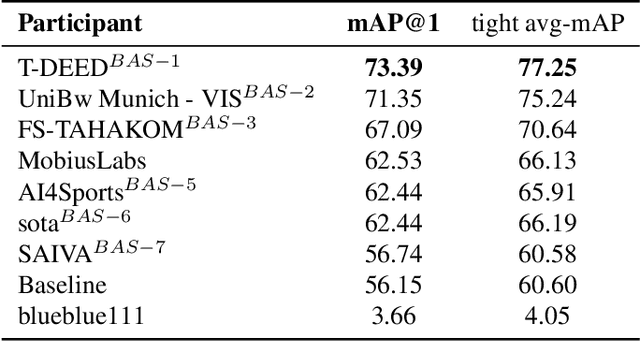
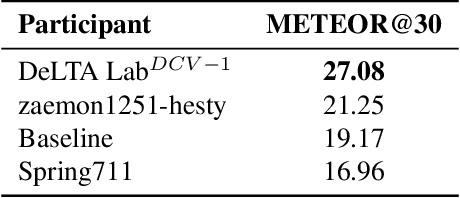
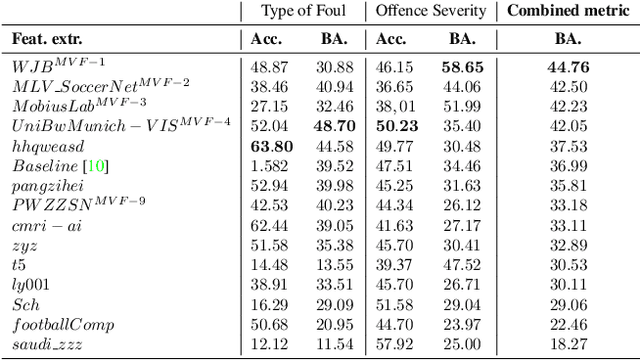
Abstract:The SoccerNet 2024 challenges represent the fourth annual video understanding challenges organized by the SoccerNet team. These challenges aim to advance research across multiple themes in football, including broadcast video understanding, field understanding, and player understanding. This year, the challenges encompass four vision-based tasks. (1) Ball Action Spotting, focusing on precisely localizing when and which soccer actions related to the ball occur, (2) Dense Video Captioning, focusing on describing the broadcast with natural language and anchored timestamps, (3) Multi-View Foul Recognition, a novel task focusing on analyzing multiple viewpoints of a potential foul incident to classify whether a foul occurred and assess its severity, (4) Game State Reconstruction, another novel task focusing on reconstructing the game state from broadcast videos onto a 2D top-view map of the field. Detailed information about the tasks, challenges, and leaderboards can be found at https://www.soccer-net.org, with baselines and development kits available at https://github.com/SoccerNet.
CO2Wounds-V2: Extended Chronic Wounds Dataset From Leprosy Patients
Aug 20, 2024Abstract:Chronic wounds pose an ongoing health concern globally, largely due to the prevalence of conditions such as diabetes and leprosy's disease. The standard method of monitoring these wounds involves visual inspection by healthcare professionals, a practice that could present challenges for patients in remote areas with inadequate transportation and healthcare infrastructure. This has led to the development of algorithms designed for the analysis and follow-up of wound images, which perform image-processing tasks such as classification, detection, and segmentation. However, the effectiveness of these algorithms heavily depends on the availability of comprehensive and varied wound image data, which is usually scarce. This paper introduces the CO2Wounds-V2 dataset, an extended collection of RGB wound images from leprosy patients with their corresponding semantic segmentation annotations, aiming to enhance the development and testing of image-processing algorithms in the medical field.
Mask-guided Data Augmentation for Multiparametric MRI Generation with a Rare Hepatocellular Carcinoma
Jul 30, 2023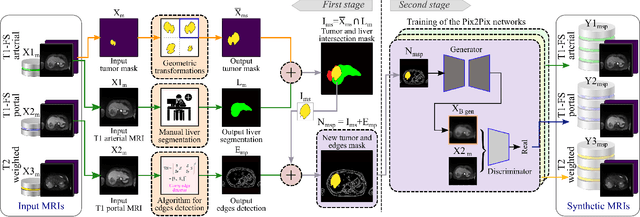
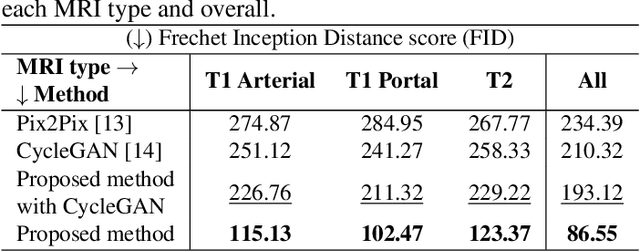
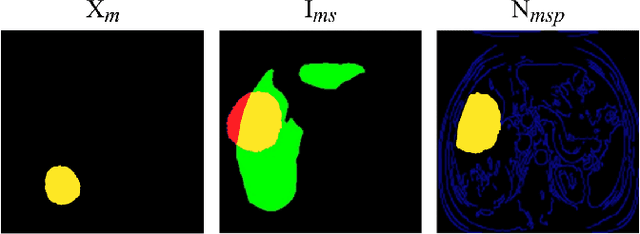
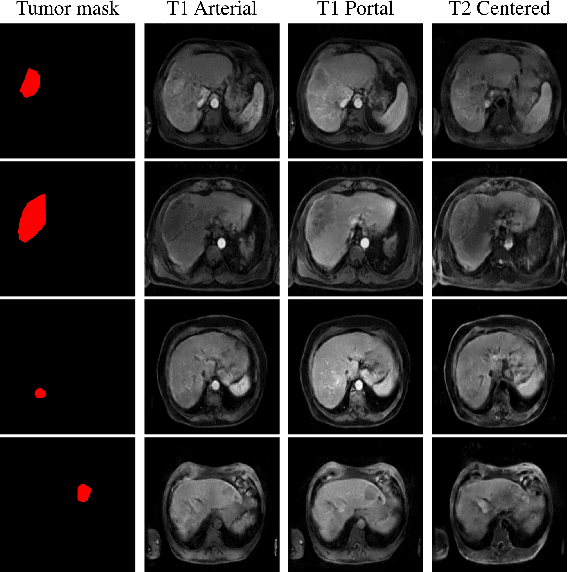
Abstract:Data augmentation is classically used to improve the overall performance of deep learning models. It is, however, challenging in the case of medical applications, and in particular for multiparametric datasets. For example, traditional geometric transformations used in several applications to generate synthetic images can modify in a non-realistic manner the patients' anatomy. Therefore, dedicated image generation techniques are necessary in the medical field to, for example, mimic a given pathology realistically. This paper introduces a new data augmentation architecture that generates synthetic multiparametric (T1 arterial, T1 portal, and T2) magnetic resonance images (MRI) of massive macrotrabecular subtype hepatocellular carcinoma with their corresponding tumor masks through a generative deep learning approach. The proposed architecture creates liver tumor masks and abdominal edges used as input in a Pix2Pix network for synthetic data creation. The method's efficiency is demonstrated by training it on a limited multiparametric dataset of MRI triplets from $89$ patients with liver lesions to generate $1,000$ synthetic triplets and their corresponding liver tumor masks. The resulting Frechet Inception Distance score was $86.55$. The proposed approach was among the winners of the 2021 data augmentation challenge organized by the French Society of Radiology.
AgroTIC: Bridging the gap between farmers, agronomists, and merchants through smartphones and machine learning
May 21, 2023



Abstract:In recent years, fast technological advancements have led to the development of high-quality software and hardware, revolutionizing various industries such as the economy, health, industry, and agriculture. Specifically, applying information and communication technology (ICT) tools and the Internet of Things (IoT) in agriculture has improved productivity through sustainable food cultivation and environment preservation via efficient use of land and knowledge. However, limited access, high costs, and lack of training have created a considerable gap between farmers and ICT tools in some countries, e.g., Colombia. To address these challenges, we present AgroTIC, a smartphone-based application for agriculture that bridges the gap between farmers, agronomists, and merchants via ubiquitous technology and low-cost smartphones. AgroTIC enables farmers to monitor their crop health with the assistance of agronomists, image processing, and deep learning. Furthermore, when farmers are ready to market their agricultural products, AgroTIC provides a platform to connect them with merchants. We present a case study of the AgroTIC app among citrus fruit farmers from the Santander department in Colombia. Our study included over 200 farmers from more than 130 farms, and AgroTIC positively impacted their crop quality and production. The AgroTIC app was downloaded over 120 times during the study, and more than 170 farmers, agronomists, and merchants actively used the application.
 Add to Chrome
Add to Chrome Add to Firefox
Add to Firefox Add to Edge
Add to Edge